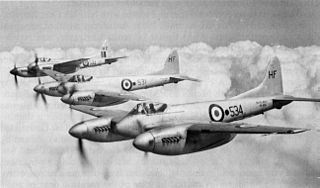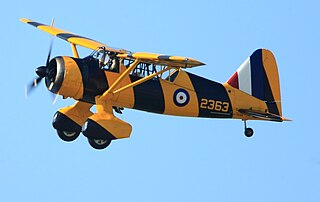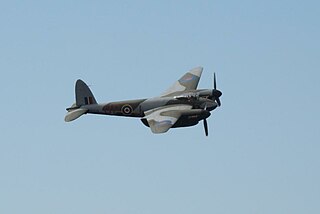
Royal Naval Air Station Lee-on-Solent,, is a former Royal Naval Air Station located near Lee-on-the-Solent in Hampshire, approximately 4 miles (6.44 km) west of Portsmouth, on the coast of the Solent.

737 Naval Air Squadron was a Naval Air Squadron of the Royal Navy's Fleet Air Arm. It was initially active during 1943 as an amphibious Bomber Reconnaissance Training Squadron. Reactivated in 1944 it operated as an ASV Training Unit until 1945. It was active again between 1949 and 1957. From 1959 it was the Anti-Submarine Warfare school at RNAS Portland. It operated Westland Wessex HAS.3 rescue helicopters from their land base at RNAS Portland, Dorset.

778 Naval Air Squadron was a Naval Air Squadron of the Royal Navy's Fleet Air Arm. During the Second World War the squadron was a Service Trials Unit (STU) initially based at HMS Daedalus, RNAS Lee-on-Solent, Hampshire, England before moving to HMS Condor, RNAS Arbroath, Angus, Scotland on 6 July 1940. The squadron tested all types of aircraft that could be used by the Royal Navy. Key to this was testing new types for deck landing on aircraft carriers. Such aircraft included various types of Supermarine Seafires, Grumman Hellcats, Grumman Martlets, Grumman Avengers, and Vought Corsairs. The squadron was reformed on 5 November 1951 with Douglas Skyraider AEW.1 but was disbanded on 7 July 1952 to form the basis of 849 Naval Air Squadron.

739 Naval Air Squadron was a Naval Air Squadron of the Royal Navy's Fleet Air Arm, which disbanded during 1950. It was formed as the Blind Approach Development Unit for the Fleet Air Arm, operating with Fairey Fulmar and Fairey Swordfish aircraft, at RNAS Lee-on-Solent, in 1942. Just under one year later the squadron moved to RNAS Worthy Down, in late 1943 and continued in the role. Roughly one year later the squadron moved again, relocating to RNAS Donibristle in late 1944, disbanding in 1945. It reformed in 1947 and was based at RNAS Culham, with a new role, as the Fleet Air Arm Photographic Trials and Development Unit.

753 Naval Air Squadron was a Naval Air Squadron of the Royal Navy's Fleet Air Arm. It was active as an Observer Training Squadron from 1939 to 1946 as part of No. 2 Observer School, forming out of the School of Naval Co-operation RAF, in May 1939. Initially at RNAS Lee-on-Solent, the squadron moved to RNAS Arbroath just over one year later in August 1940, following a German bombing attack on the air station. It spent four years operating out of Arbroath, before relocating again, this time to RNAS Rattray, where the squadron disbanded in August 1946.

754 Naval Air Squadron was a Naval Air Squadron of the Royal Navy's Fleet Air Arm. It was active as an Observer Training Squadron from 1939 to 1944 as part of No. 2 Observer School, forming out of the School of Naval Co-operation RAF, in May 1939. It initially operated out of HMS Daedalus, RNAS Lee-on-Solent, Hampshire, however, after the Naval Air Station was attacked and bombed, it then moved to north to HMS Condor, RNAS Arbroath, Angus, Scotland, in September 1940. Here, it provided training for Observers and also Air Gunners and where four years later, in March 1944, it disbanded. The squadron then briefly reformed as a Air Gunner Training Squadron, as part of No. 1 Naval Air Gunners School, when 744 Naval Air Squadron was re-designated 754 Naval Air Squadron, in June 1944, at RN Air Section Yarmouth, Nova Scotia, Canada, until disbanding again, in March 1945.

758 Naval Air Squadron was a Naval Air Squadron of the Royal Navy's Fleet Air Arm. It was initially formed as a Telegraphist Air Gunner Training Squadron, from 1939 and 1941, renumbered from 759 Naval Air Squadron, operating out of RNAS Eastleigh. It moved to RNAS Arbroath, in 1940, disbanding there the following year. The squadron reformed at RNAS Donibristle, in 1942, as a Beam Approach School. Moving to RNAS Hinstock, it was known as the Naval Advanced Instrument Flying School. It provided instrument courses, utilising a large number of Oxford aircraft, with detachments sent to the specialised flying schools at RNAS Crail, RNAS East Haven, RNAS Fearn and RNAS Yeovilton. 'X' and 'Y' Rover Flights supplemented the detachments, 'Z' Flight was on calibration work and evolving homing and landing capabilities, with the squadron disbanding in 1946, at RNAS Peplow, into 780 Naval Air Squadron.

762 Naval Air Squadron was a Naval Air Squadron of the Royal Navy's Fleet Air Arm (FAA). It formed at HMS Heron, RNAS Yeovilton, in March 1942 as an Advanced Flying Training School. Almost immediately the squadron relocated to HMS Vulture, RNAS St Merryn, but before the end of the year, it was back at HMS Heron. The squadron disbanded nine months later. It reformed in 1944 at HMS Daedalus, RNAS Lee-on-Solent, as a Twin Engine Conversion Unit, but immediately moved to HMS Goldcrest, RNAS Dale, where it operated a variety of multi engined aircraft. At the end of 1945 the squadron moved to HMS Sparrowhawk, RNAS Halesworth and HMS Peregrine, RNAS Ford in quick succession. Now known as the Heavy Twin Conversion Unit it spent nearly two and a half years at HMS Peregrine, before relocating to HMS Seahawk, RNAS Culdrose, where it eventually disbanded at the end of 1949.

764 Naval Air Squadron was a Naval Air Squadron of the Royal Navy's Fleet Air Arm. It initially formed in April 1940, at HMS Daedalus, RNAS Lee-on-Solent, as an Advance Seaplane Training Squadron. The Squadron moved to RAF Pembroke Dock in July 1940, and later to HMS Daedalus II, RNAS Lawrenny Ferry in October 1941 and remaining there until the Squadron disbanded in November 1943. It reformed at HMS Siskin, RNAS Gosport, in February 1944, as the User Trials Unit, however, the squadron was decommissioned for the second time in September 1945. 764 Naval Air Squadron reformed again, at HMS Fulmar, RNAS Lossiemouth, in May 1953, where it became an Advanced Training Unit. It moved to HMS Heron, RNAS Yeovilton, in September 1953, where it received its first jet aircraft. In November 1954 the Squadron disbanded.

768 Naval Air Squadron was a Naval Air Squadron of the Royal Navy's Fleet Air Arm (FAA). It last disbanded at HMS Gannet, RNAS Eglinton, Northern Ireland, in March 1949, having been formed as a Deck Landing Control Officer Training Squadron, in December 1948, to ensure one American-style signal trained DLCO could be located at every FAA station. It first formed as part of the Deck Landing Training School at HMS Condor, RNAS Arbroath, in January 1941, as a Deck Landing Training Squadron. Advanced training was in HMS Argus, for which a detachment was maintained at HMS Landrail, RNAS Machrihanish, where it wholly moved to in March 1943. September saw a move to RAF Heathfield, Ayr, followed by a further move to HMS Sanderling, RNAS Abbotsinch in January 1944. Training used escort carriers on the Firth of Clyde and a detachment was maintained at (Heathfield)Ayr throughout this period, with the squadron returning there in July 1945, at this time HMS Wagtail, RNAS Ayr. In August the squadron moved to HMS Corncrake, RNAS Ballyhalbert in Northern Ireland but then in October it joined up with the Deck Landing School at HMS Peewit, RNAS East Haven, Scotland, where it disbanded in April 1946.

770 Naval Air Squadron was a Naval Air Squadron of the Royal Navy's Fleet Air Arm. It last disbanded at HMS Nighthawk, RNAS Drem in October 1945. 770 Naval Air Squadron initially formed as a Deck Landing Training Squadron at HMS Daedalus, RNAS Lee-on-Solent, in November 1939. Embarked in HMS Argus, and operated from the aircraft carrier and Hyeres la Palyvestre in the south of France, until it disbanded in May 1940. It reformed at HMS Merlin, RNAS Donibristle, on New Year’s Day 1941, as a Fleet Requirements Unit out of 771 Naval Air Squadron’s 'X' Flight. It moved to HMS Jackdaw, RNAS Crail, in June 1941, then two and half years later it moved to HMS Jackdaw II, RNAS Dunino in January 1944, before finally moving to HMS Nighthawk in July.

773 Naval Air Squadron was a Naval Air Squadron of the Royal Navy's Fleet Air Arm which was last active between September 1950 and March 1951. 773 Naval Air Squadron initially formed during June 1940, as a Fleet Requirements Unit in Bermuda, in support of ships on the North America and West Indies Station. It performed this role four almost four years and eventually disbanded, at Bermuda, in April 1944. The squadron reformed during June 1945 as a Service Trials Unit, at HMS Daedalus, RNAS Lee-on-Solent. Tasked with investigating pilotless aircraft as targets, it was known as the Pilotless Aircraft Unit (PAU). It moved to HMS Goldcrest II, RNAS Brawdy where it disbanded in September 1946. The squadron reformed at the start of 1949 as a Fleet Requirements Unit, out of 771 Naval Air Squadron, lasting around three months and repeated this at the start of 1950 and again at the end of 1950, into 1951.

776 Naval Air Squadron was a Naval Air Squadron of the Royal Navy's Fleet Air Arm which last disbanded at the end of October 1945. 776 Naval Air Squadron formed as a Fleet Requirements Unit at HMS Daedalus, RNAS Lee-on-Solent, at the start of 1941. It operated a detachment at RN Air Section Speke in 1941 and one at RAF Woodvale in 1942, with the squadron wholly moving to Speke in the October. 1943 saw further detachments and these were deployed at RAF Llanbedr, RAF Millom, RAF Usworth and RAF Waltham. In April 1945, the Woodvale detachment was reabsorbed into the squadron when it relocated there, the airbase now operated by the Admiralty and known as HMS Ringtail II. It moved to HMS Ringtail, RNAS, Burscough, at the start of October 1945.

780 Naval Air Squadron was a Naval Air Squadron of the Royal Navy's Fleet Air Arm which last disbanded at HMS Seahawk, RNAS Culdrose in November 1949. 780 Naval Air Squadron formed at HMS Raven, RNAS Eastleigh as a Conversion Course Unit, in October 1939, to train experienced civilian pilots in naval flying. It moved to HMS Daedalus, RNAS Lee-on-Solent, in October 1940, and later, its role had changed to converting pilots to Fairey Barracuda aircraft. It spent a year at RNAS Charlton Horethorne, before returning to HMS Daedalus and disbanded, early 1945. In March 1946, the squadron reformed at HMS Godwit, RNAS Hinstock, as the Naval Advanced Flying School, to give flying instructors' courses, and later provided Instrument Flying Training. In December, the squadron moved to HMS Jackdaw, RNAS Crail, then in March 1947 moved to HMS Merlin, RNAS Donibristle, and in May to HMS Seahawk as the first resident unit.

781 Naval Air Squadron was a Naval Air Squadron of the Royal Navy's Fleet Air Arm which disbanded at the end of March 1981. Planned as a Reserve Amphibious Bomber Reconnaissance squadron, it formed as a Communications Unit in March 1940 and operated a large variety of aircraft. It provided a Bristol Beaufighter conversion course which eventually became 798 Naval Air Squadron and also had a ‘B’ Flight at Heathrow and then Heston aerodromes before becoming 701 Naval Air Squadron. After the Allied invasion of Normandy the squadron flew to various Royal Navy units on the continent and established an ‘X’ Flight based in France and then Germany. In July 1945 the squadron disbanded into 782 Naval Air Squadron although the ‘X’ Flight was moved to 799 Naval Air Squadron.

782 Naval Air Squadron was a Naval Air Squadron of the Royal Navy's Fleet Air Arm. It initially formed in October 1939 as an Armament Training Squadron but disbanded in November to provide personnel for 774 Naval Air Squadron. In December 1940 it reformed at HMS Merlin, RNAS Donibristle, as the Northern Communications Squadron, providing links between the Naval Air Stations in Scotland, Northern Ireland, and the Shetland and Orkney islands. It finally disbanded in October 1953.

783 Naval Air Squadron was a Naval Air Squadron of the Royal Navy's Fleet Air Arm which last disbanded in November 1949. 783 Naval Air Squadron was formed as an ASV Training Squadron at HMS Condor, RNAS Arbroath, Scotland, in January 1941. It operated a number of ‘flying classroom’ aircraft alongside other types. It operated in conjunction with the Naval Air Signals School (NASS) from March 1943. The squadron moved to HMS Daedalus, RNAS Lee-on-Solent, England, when the NASS moved south, also supporting the Flag Officer, Air, Home Communications Officer and from July 1948,it was part of the 51st Miscellaneous Air Group.

787 Naval Air Squadron was a Naval Air Squadron of the Royal Navy's Fleet Air Arm which disbanded in January 1956. It formed in March 1941, at HMS Heron, RNAS Yeovilton, out of 804 Naval Air Squadron as a Fleet Fighter Development Unit. Almost every type of fighter was received by the squadron for testing and evaluation for naval use. A move to RAF Duxford in June 1941 saw it become the Naval Air Fighting Development Unit, attached to the Royal Air Force's Air Fighting Development Unit. The squadron undertook rocket projectile test, continuous development of fighter tactics and even helping Torpedo Bomber Reconnaissance squadrons in evading fighter attack. Post Second World War it continued its trials task and also undertook Rebecca radar trials and ASH, US-built air-to-surface-vessel radar trials.

797 Naval Air Squadron was a Naval Air Squadron of the Royal Navy's Fleet Air Arm which last disbanded in October 1945 in Ceylon. Its role was a Fleet Requirements Unit which formed at HMS Ukussa, Royal Naval Air Station Katukurunda, in Ceylon, in July 1942. The squadron moved to RNAS Colombo Racecourse in October 1943. It had a Communications Flight which became 742 Naval Air Squadron in December 1943 and the following summer it had an ‘X’ Flight deployed for target towing for a couple of gunnery schools in Bombay, India and which eventually moved to 722 Naval Air Squadron.

799 Naval Air Squadron was a Naval Air Squadron of the Royal Navy's Fleet Air Arm which last disbanded during August 1952. It initially formed as a Pool Squadron in South Africa during September 1943, sharing Fairey Albacore aircraft with 798 Naval Air Squadron and providing flying time for aircrew prior to front line squadron assignment, disbanding in June 1944. It reformed in July 1945 as a Flying Check and Conversion Refresher Squadron at HMS Daedalus, RNAS Lee-on-Solent. Made up of three distinct flights, two of those operated away from Lee-on-Solent with a flight at HMS Siskin, RNAS Gosport, giving junior officers air experience, and another flight at HMS Dipper providing Supermarine Sea Otter conversion training. By May 1948 the whole unit had moved to HMS Heron, RNAS Yeovilton. In 1951, 799 Naval Air Squadron relocated to RNAS Machrihanish.




















